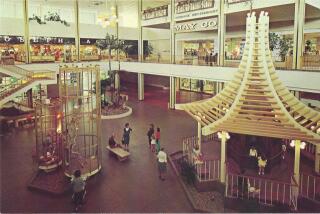Store windows now part of Christmas past
- Share via
WASHINGTON — Once, we made special trips downtown this time of year, lining up to gape at mechanical bears eating porridge, Victorian cats celebrating in the snow and toy soldiers guarding over our happy holidays.
Now those same jumbo-size windows in re-purposed downtown department store buildings offer views of advertising signs, old photos and waiters grinding $12 guacamole.
This is progress?
The grand old animated Christmas window displays of the sort that once had department stores competing to demonstrate their creative extravagance are now relegated to nostalgic memories, scenes in old movies and on New York’s Fifth Avenue (and even there, the competing stores’ windows are all produced by one company).
The reasons for the demise of the Christmas window are well-known: the decline of the downtown department store, the rise of windowless big-box retailers, the replacement of family-owned local shops by big national chains and the triumph of convenience over showmanship.
“It was an amenity of the walking-around town,” says William “Larry” Bird, a Smithsonian curator whose new book, “Holidays on Display,” tells the story of the art and business of the window shows. “Department stores lived and died by their windows. They spared no expense. This was the secular creche.”
Oddly enough, in this era in which technology has made it possible to personalize retailing as never before, consumers expect less in the way of service and splendor. Businesses that once rose or fell on their ability to lavish customers with service -- airlines, supermarkets, department stores -- now compete to cut costs. Any notion of romance in shopping has yielded to the utilitarian imperative.
The old Washington department store Woodward & Lothrop -- known for decades as Woodies -- spent $200,000 a year on animated window displays in the 1970s. These days, the Seattle-based department store Nordstrom is cutting back on its trademark piano players, eliminating live music from about half of its stores while trimming pianists’ hours at others.
Nordstrom has an animated holiday display in the windows of one store, in downtown Seattle, where a Santa’s Village show is maintained only because the company took over that location from a local business, Frederick & Nelson, which had a long tradition of Christmas windows.
Most big cities have gone a decade or more without holiday window displays, and though the art form may seen archaic and quaint to people growing up in a world of e-retailing, the tradition retains as strong a hold on the public imagination as Thanksgiving Day parades.
Bird recalls that when it became clear in 1994 that Woodies was about to die, the store put up one last Christmas display -- in October. After the doors closed, customers kept showing up to look for the windows.
When the developer who owns the Woodies building here saw a steady stream of disappointed visitors outside, he and the downtown business improvement district installed animated soldiers, animals and dolls in a Potemkin window, and everyone agreed not to think about the empty building behind the display.
Today, the old Woodies is home to retailers again, sliced into spaces for clothing and furniture stores. But there are no holiday shows in those windows.
The time when stores had in-house designers and decorators is probably gone forever. But isn’t it inevitable that a backlash will arise against cynical retailers who take advantage of our do-it-yourself culture and push customers to bag their own groceries, carry their own peanuts onto planes, build their own furniture and figure out for themselves whether the shoe fits?
Of course, nobody needs a piano serenade while they shop for shirts or a Christmas show on their way to buy a gift. Any time we lop off the fantasy and romance from our daily lives, though, we are hacking away at the quality of our existence.
More to Read
Inside the business of entertainment
The Wide Shot brings you news, analysis and insights on everything from streaming wars to production — and what it all means for the future.
You may occasionally receive promotional content from the Los Angeles Times.










